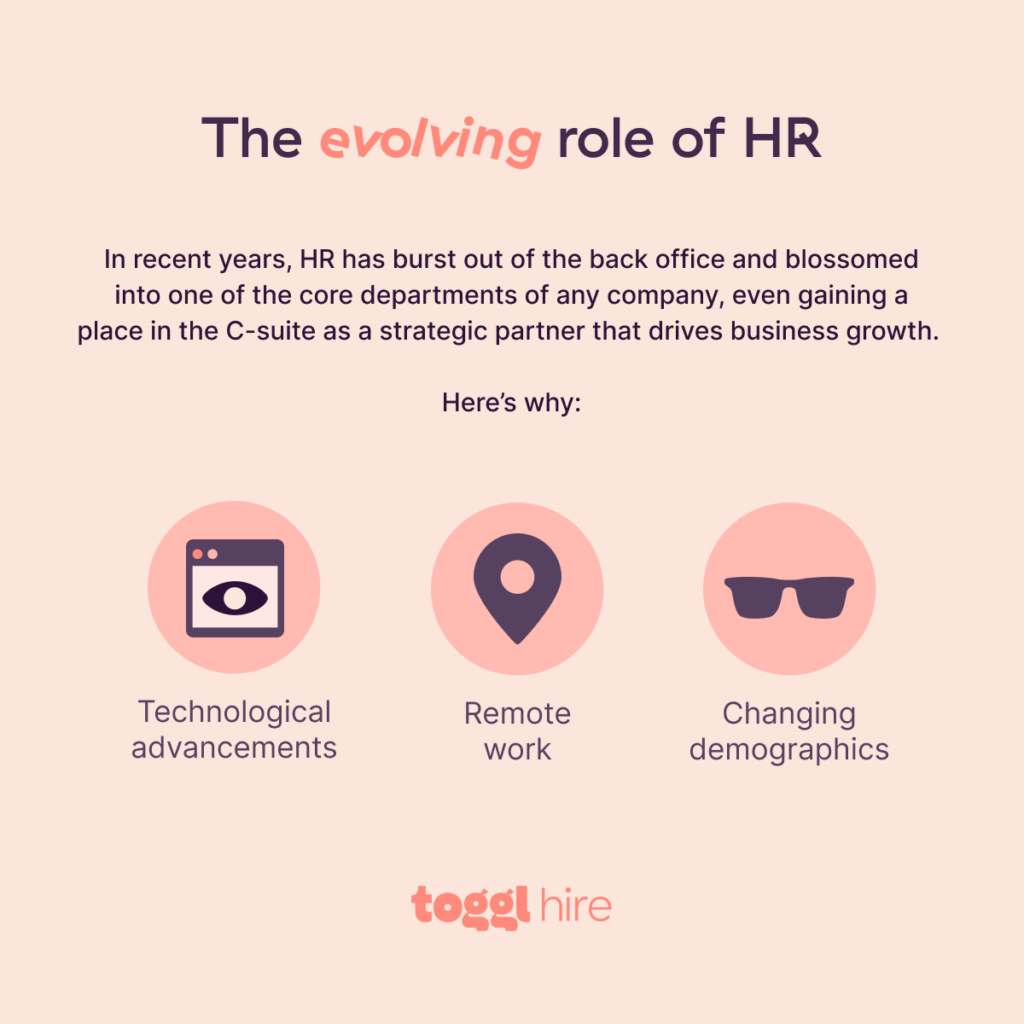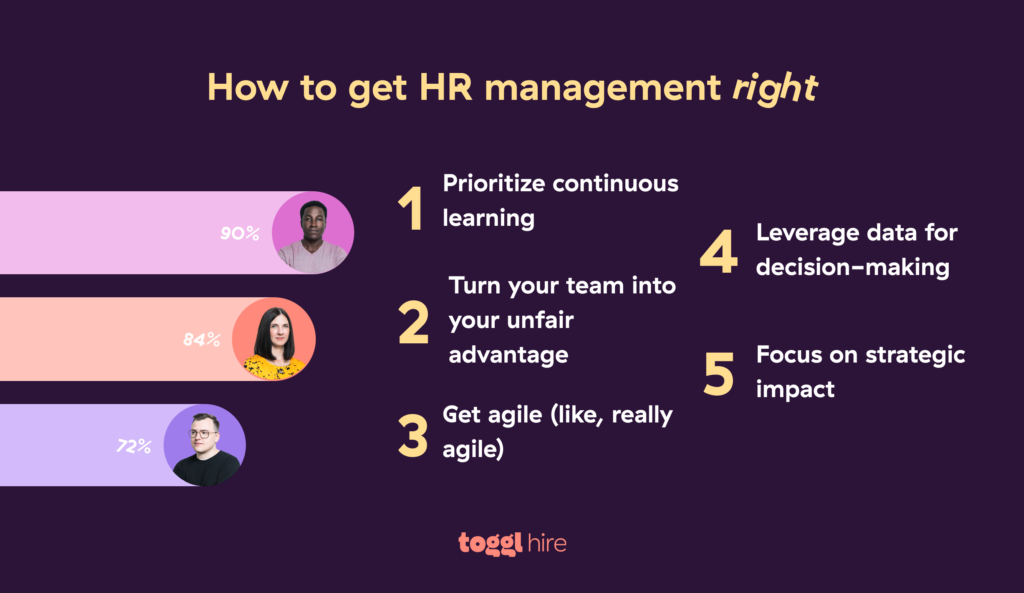“Talent teams are living in the craziest hiring market of all time.” If these words from our wonderful Head of People got you nodding in agreement with a side of “don’t I know it,” you’re probably thinking about your game plan for 2025.
What it means to work in HR has changed drastically over the last two decades. Managing the increased scope of work, technological boom, and changing demographic needs can make running an HR team feel like juggling in Cirque du Soleil.
As we steamroll into 2025 (seriously, can time stop flying?), this evolution shows no signs of slowing down. It’s no longer enough to react to issues as they arise — HR leaders need to anticipate future needs and proactively create systems that empower the organization and its people to thrive.
So, how can you set your team members up for success in 2025? There are 11 HR functions to have on your radar.
TL;DR — Key Takeaways
- The scope of HR has evolved from back-office ops to a leading role in the strong heartbeat of a thriving company.
- Technology, globalization, remote work, and demographics are key drivers of this shift, which isn’t slowing down anytime soon.
- HR teams must leverage AI and other software to free time to spend on more strategic tasks. A big part of the game is anticipating needs and acting before they become bottlenecks.
- Company culture and employee engagement are key to retaining top talent.
- We’re in a hyper-competitive market, and reviewing and upgrading your compensation, training, and professional development packages will capture candidate attention.
- Tackling all 11 pillars might be unrealistic for some businesses. Prioritize and master the core HR functions your organization would benefit most from.
The evolving role of human resources
Traditionally, the HR department was more of a behind-the-scenes operation. It handled administrative tasks such as payroll, benefits administration, and compliance — the unglamorous but necessary stuff that kept the ship sailing.
In recent years, HR has burst out of the back office and blossomed into one of the core departments of any company, even gaining a place in the C-suite as a strategic partner that drives business growth. There are a few reasons for this shift in HR function:
- Technological advancements: The advent of HR software and AI has automated routine tasks, freeing up HR professionals’ time and energy to focus on more strategic initiatives.
- Remote work: Increasing globalization and access to technology has expanded workforces across borders. With this comes a new set of opportunities and challenges, such as managing cultural differences and navigating complex labor laws.
- Changing demographics: Gen Z now makes up over a quarter of the workforce, and their expectations and values are different from any generation before them. Plus, the rise of the gig economy, paired with an aging workforce, requires HR to rethink traditional approaches to employment
Today, one of the main functions of HR is fostering organizational culture and driving employee engagement. In addition to the traditional “admin-y” HR responsibilities, leaders are also in charge of creating inclusive workplaces, supporting mental health care initiatives, and promoting diversity. Together, these initiatives all contribute to fostering a motivated and productive team.
But modern times bring modern challenges. Adapting to remote and hybrid work, maintaining company culture and productivity, caring for employee wellbeing, and ensuring equity and inclusion in the workplace require a flexible, forward-thinking, and innovative HR team that can meet evolving organizational needs.

11 key functions of human resources to focus on (and improve)
If you want to remain competitive in 2025 — attract top talent, retain top performers, and create a workplace where everyone feels valued and supported across the whole employee life cycle — read on. These HR functions are gonna be an (even more) vital part of your toolbox.
1. Human resource planning
In 2025, HR will go beyond a reactive recruitment process, moving instead to a proactive approach to building out your personnel pipeline. Workforce analytics and predictive modeling will forecast the organization’s needs before they become a bottleneck.
It will be HR’s task to anticipate these needs and always be one step ahead of the game, keeping eyes and ears out for potential additions to the company. Staying ahead of these curves gives organizations an unfair advantage when it comes to talent management and succession planning. If you’re the first to realize what you need, you’re most likely to get it before the pickings are slim.
Creating adaptable plans that reflect changes like skills gaps, economic shifts, or unexpected crises will be a core ingredient for successful HR planning in 2025.
2. Recruitment and selection
There’s no denying it. Hiring top talent drives organizational success. In 2025, AI-powered applicant tracking systems and skills-based hiring will be key parts of recruiters’ tech stacks. This builds on the momentum from 2024, with 73% of recruitment professionals saying hiring based on skills was a top priority.
Diversity and seamless candidate experiences are also important parts of HR’s remit. Diverse hiring strategies foster innovation, creative problem-solving, and profitability, while a great candidate experience showcases fairness and transparency, which in turn attracts top talent.
As the competition for talent intensifies in 2025, stay competitive by keeping your hiring process as efficient as possible. That could look like turning to AI-driven tools, async video interviews, or prioritizing building a talent pool. These will all help you reduce time-to-hire without sacrificing the quality of your new hires.
3. Company culture
Company culture has two faces. On the one hand, it drives internal engagement and job satisfaction. On the other, it fuels external brand perception and public reputation. By building a culture of trust, transparency, and shared values, you can attract the right kind of people instead of ending up with a bunch of square pegs for your round holes.
If you want to strengthen company culture, try one of these strategies:
- Gather employee feedback regularly and act on it
- Promote open communication across all levels of the organization
- Recognize employee achievements publicly, give constructive criticism privately
- Align leadership actions with company values
With the increasing demand for authenticity in the workplace amongst younger generations, it’ll pay to lean into showing who you are as an organization.
4. Employee engagement
We know engaged employees are happier, healthier, and more productive, creative, and loyal than their unengaged counterparts. But reaching this point can seem an impossible challenge. Gallup’s research points to managers as the secret sauce. Its study of 83,000 business units across 25 years concluded:
“Great managers, who are closest to their employees, are the key to inspiring extraordinary performance.”
Your line managers are gold. Keep them in regular communication with their teams, and remember that communication is a two-way street — employees need to feel heard, too. A culture of praise, trust, and meaningful work goes a long way.
One way to kick-start this is with pulse surveys, which usually contain 1-3 questions sent out at regular intervals to check your team’s “pulse” in real time. If you don’t want your top talent to “quiet quit” in 2025, we recommend getting a jump on this HR function.
5. Performance management
Employee performance management is also shifting from a yearly appraisal to an ongoing function. This ties in with what we talked about earlier — the future of HR is flexible and adaptable. Why wait until the scheduled annual review to address shortcomings, set new goals, or let people know they’re killing it?
Instead, try setting clear goals with regular milestones and check-ins. You should also incorporate real-time feedback, and lean into being a support pillar for your employees and team. Help them develop the skills they want in alignment with your business objectives.
Tools like 15Five, Culture Amp, and Workday are designed to give unbiased, data-driven performance reviews. They analyze metrics, track goals, and gather 360-degree feedback to help you and your team grow year-round.
6. Employee development
Employees want to grow — one demographic in particular above all others.
“Gen Z really values learning and career development opportunities. If you’re not investing in their growth, you’re not going to be able to hold onto them. They will prioritize their own career paths over any long-term commitment to an organization,” says Nicky Vallelly of Google Deepmind.
When it comes to employee value propositions, Gen Z is 36% more likely than other generations to prioritize advancement opportunities and 34% more likely to prioritize skill development opportunities.
Try introducing personalized training programs, microlearning, or e-learning platforms like Coursera, Masterclass, and LinkedIn Learning. Hard skills are important but don’t overlook the power of future-proofing your employees with knowledge relevant to upcoming trends like AI and sustainability.
Going the extra mile will make your business more resilient to changing needs and trends in today’s volatile marketplace by future-proofing your employees.
7. Function evaluation
Function evaluation is a bit meta. It’s all about assessing HR’s effectiveness as a department—how well is it contributing to overall business goals?
Start by looking under the hood. Metrics like overall company turnover rates, average time to hire, and employee satisfaction can point you in the direction of areas that might need more TLC.
Systemizing how you approach this is important to maintain fair evaluations and give strategies the time they need to bear fruit. You can approach this by conducting regular HR audits, for example, every quarter.
8. Compensation and benefits
For millennials, compensation is the #1 most important employee value proposition. They also value it more than any other generation (it makes sense; they were entering the workforce during the biggest financial crisis since the Great Depression).
Millennials make up 75% of the global workforce, so it’s super important you pay them well if you want them to stick around. This includes other elements of your employee benefits packages, including bonuses and incentives, too. Get this wrong and poor pay is the top reason employees will quit their jobs, according to SHRM.
Go the extra mile! Don’t just pay your team well. Give them the resources to make their money work for them. Financial literacy and financial wellness programs are great entry points for this. Let employees manage their own benefit budgets. Empowering them to make their own choices allows you to offer personalized employee benefits at scale, which cater to diverse workforce needs and build loyalty and work-life balance without adding extra workload on you.
9. Review company policies
I know, I also shudder at the words “company policy.” But honestly, they’ve gotten a bad rap. Company policies are a saving grace, especially in remote or hybrid work environments.
They provide fair and transparent clarity around what is and isn’t allowed. That said, they still need to be kept up-to-date, inclusive, and reflect evolving workplace needs. Policies should be accessible to all employees, and their location (whether digital or physical) should be actively communicated.
Reviewing company policies is one of those things that tends to drift further and further down your to-do list. If you’re struggling with getting it done, get your employees involved in the process! Not only will you get their feedback (which might show you it doesn’t work for everyone anymore — we can’t see our own blind spots), but they’ll act as accountability buddies for you to get the task done.
10. Employee well-being
Mental health is a key part of your 2025 employee wellbeing strategy. 92% of workers prioritize organizations that support mental health, and 95% value respect for work-life boundaries. Implementing mental health support programs and stress management workshops can significantly improve workplace morale.
Don’t see the ROI in this and need to convince the higher-ups it’s actually worth prioritizing? Tell them that a supportive environment leads to increased productivity and organizational success, so definitely worth investing in.
11. Health and safety
Health and safety might be easily overlooked, but it’s fundamental. Not only do employers have a legal duty of care under regulations like the Occupational Safety and Health Act (OSHA), which mandates safe working conditions, but investing in workplace safety leads to returns of 24% to 114%.
In an era defined by pandemics, climate change, and chronic lifestyle diseases, this is equally important in digital-first roles (e.g., health insurance benefits) as in manual jobs. In both cases, businesses benefit from creating dynamic plans that consider work security and emergency preparedness.
Transparency in communication, regular training, and compliance with global standards are essential for protecting employees. By prioritizing these areas, companies can foster a safer work environment, ultimately enhancing employee well-being and productivity.
Tips for getting human resource management right in 2025
Start improving your approach to human resource management (HRM) today by following these tips and best practices.
Prioritize continuous learning
Tune into industry webinars, earn certifications, and follow thought leaders to stay up-to-date on best practices. Adopting a growth mindset and leaning into curiosity can set the right tone for an innovative, adaptable, and winning team.
Turn your team into your unfair advantage
Introduce policies to encourage creative ideas, create cross-functional teams to solve specific problems, or apply design-thinking approaches to HR challenges. Seeing an issue from many angles usually leads to unexpected solutions.
Get agile
Applying the philosophy of rapid iteration to your human resources department can help teams adapt to changing trends like remote work, gig hiring, or shifting employee expectations. Building fast feedback loops into your process lets your team make quicker decisions.
More decisions = more employee data = more learning = everything gets smoother and better, faster.
Leverage data for decision-making
Data validates HR strategies and results by analyzing metrics such as attrition rates, engagement scores, and training ROI. It’s important to have clean, accessible data, as future initiatives will be built on these numbers. Investing in strong analytical tools is a good idea.
Focus on strategic impact
ABC. Always be checking…in with how every HR decision or initiative aligns with the organization’s strategic goals. Whether it’s in hiring, employee engagement, or policy creation, your actions should support business scalability and growth. Schedule regular planning sessions to align HR priorities with leadership’s vision.
The bottom line? The future of HR management will require a balance of tech-savvy innovation, human empathy, and strategic foresight. The more proactive and intentional HR professionals are in crafting solutions, the more likely they are to drive meaningful outcomes for their organizations.

Support HR professionals with the right tools
Modern HR challenges require modern solutions. With the ever-expanding scope of work that falls under those two letters (“HR”), responsibilities are growing in number and complexity, from managing hybrid workforces to fostering employee well-being.
Selecting the right weapons for battle has never been more important. They’ll help you drive efficiency, accuracy, and strategic impact…and keep your lunch break.
Your recruitment tech stack probably looks a ‘lil something like this:
- Reliable ATS for hiring efficiency
- Skills test tool to screen candidates fast
- Performance management systems to see how everyone’s doing in one place
- Employee engagement tools to keep up the good vibes in-house
- Background check and/or onboarding software to screen and welcome your new recruits
Maybe you’ve dabbled in emerging tech, for example, using AI for predictive insights or VR for training. In any case, you’ve probably also integrated these systems to centralize operations and keep them running as smoothly as butter.
Tools and apps amplify HR’s impact, but they can’t replace the strategic thinking, creativity, and empathy needed to support employees and the business over the long term.
Learned something new? Subscribe to our newsletter — there’s heaps more where this came from. 😉
Julia Masselos is a remote work expert and digital nomad with 5 years experience as a B2B SaaS writer. She holds two science degrees Edinburgh and Newcastle universities, and loves writing about STEM, productivity, and the future of work. When she's not working, you'll find her out with friends, solo in nature, or hanging out in a coffee shop.


